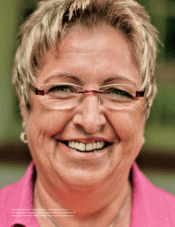Medtronic 2011 Annual Report Download - page 18
Download and view the complete annual report
Please find page 18 of the 2011 Medtronic annual report below. You can navigate through the pages in the report by either clicking on the pages listed below, or by using the keyword search tool below to find specific information within the annual report.
14
Until recently, nearly 100,000 people worldwide with severe narrowing
of their aortic heart valves could not have their ailing valves replaced.
Because of age or other medical conditions, they aren’t eligible for open-heart
surgery. We’re giving them the chance for a longer life with a transcatheter
aortic valve that doesn’t require surgery.*
To eectively help these heart valve disease patients, we
oer a nonsurgical procedure in which the articial valve
is compressed into and delivered via a catheter less than
one-quarter inch in diameter. (See diagram below right.)
We introduced the world’s rst transcatheter heart valve
back in 2006 with a pulmonary valve.** Our next priority
was to get a transcatheter aortic valve to market as soon
as possible, because one-third of the people who need
replacement aortic valves aren’t eligible for the only
other eective option: traditional open-heart surgery.
We acquired two companies to help us meet that goal:
Ventor Technologies, Ltd., a developer of transcatheter
aortic heart valve technologies, and CoreValve, Inc.,
a company with a transcatheter aortic valve that was
already available in many countries outside the United
States and had strong market share in Europe. Both
technologies include a self-expanding design — the
platform of the future — which helps make the system
smaller and less invasive. The next-generation platform
also will allow for potential future improvements, such
as better positioning of the valve.
We’re currently conducting clinical trials for the CoreValve
System in the United States to gain FDA approval.
Transcatheter heart valves allow physicians
to replace aortic valves without opening the
chest. The articial valve is delivered inside
a catheter, which typically is inserted into
the femoral artery in the groin and threaded
up to the heart, where it is expanded into
place and immediately begins taking over
for the patient’s native valve.
I am the face of possibility.
* Not approved for commercial distribution
in the United States.
** The Melody Transcatheter Pulmonary Valve
is approved under a Humanitarian Device
Exemption in the United States.
























